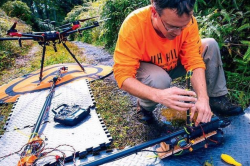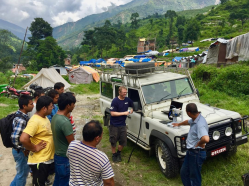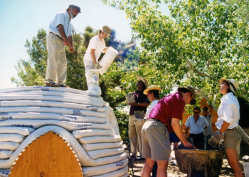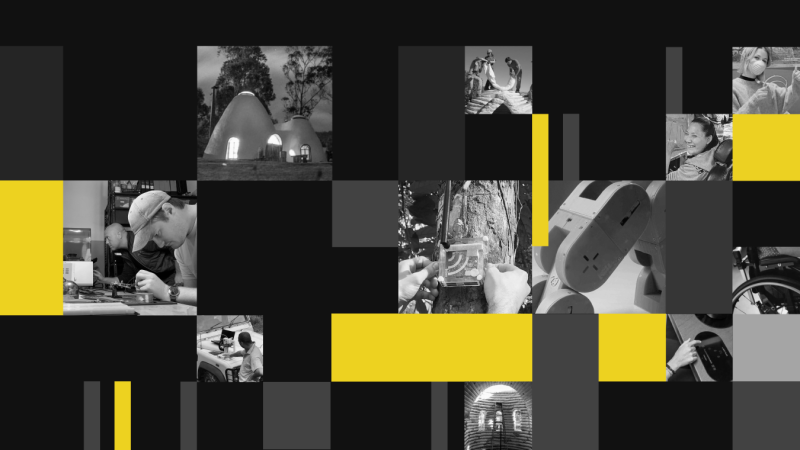The 2020 Hackaday Prize begins right now. Our global engineering challenge seeks solutions to real-world problems. If you like to come up with creative solutions to tough problems, four non-profits can use your help. We need hackers, designers, and engineers throughout the world to work on designs for conservation, disaster relief, renewable resources, and assistive devices.
 This is the seventh year of the Hackaday Prize, and like past years we want to see your ideas take shape, so share your design process in detail as a project page on Hackaday.io. Over $200,000 in prizes are at stake, with a $50,000 prize for the all around best solution which will then be designed for manufacture at Supplyframe’s DesignLab, produced in a limited run, and deployed in the field.
This is the seventh year of the Hackaday Prize, and like past years we want to see your ideas take shape, so share your design process in detail as a project page on Hackaday.io. Over $200,000 in prizes are at stake, with a $50,000 prize for the all around best solution which will then be designed for manufacture at Supplyframe’s DesignLab, produced in a limited run, and deployed in the field.
New this year is our partnership with non-profits that have each outlined challenges they are facing. Eight projects, one top finisher, and one runner up from each of the four categories of challenges, will receive $10,000 and $3,000 respectively. As with previous years, the bootstrap round offers some seed money for getting your prototype off the ground: up to $500 for each of the top twenty during early entry judging. There’s even a $5,000 wildcard prize for entries that don’t specifically address challenges from the four categories. Here’s a taste of the categories you can work on:
- Develop solutions to combat invasive species in marine and island environments, and help craft tools for protecting our natural ocean landscapes
- Low cost tools for use in the field like a heat sealers/welders, and medical devices like IV fluid warmers
- Adaptive technologies for workstations like trackballs, joysticks, and large button controllers
- Modular add-ons for earthen housing for connectivity, light, heating, and water storage
Here’s one thing we’ve never been able to do before: provide a stipend to work for two months on an engineering “Dream Team” in these areas. Our partner organizations need great engineers, and we can make that happen. The Hackaday Prize includes team microgrants of $3,000 per month available for each of twelve engineers selected to work full time in June and July on the Dream Team challenges. Let’s meet the non-profits and find what this new bit is all about.
Meet the Non-Profits and the Dream Team Challenges
The people who understand the problems best are those who face them in the field. We’re proud to partner with four non-profit organziations this year who have their finger on the pulse of where help is needed.

Conservation X Labs
Faced with the sixth mass extinction, Conservation X Labs focuses on solving the drivers of this extinction, promoting conservation systems that protect wildlife health and improve the ecosystem.
Conservation X Labs’ Dream Team challenge is to design systems for reducing the amount of lost or abandoned items in the world’s oceans, particularly in the fishing industry.

Field Ready
This year we’ve seen how difficult it becomes when supply chains break down. Field Ready focuses on rapid manufacturing in the field, helping with designs for disaster recovery or humanitarian crisis.
Field Ready’s Dream Team challenge is to design a tracking system that evaluates effectiveness of solutions, helps ensure quality control, and makes repair and replication of existing solutions possible.

United Cerebral Palsy LA
Advancing the independence and productivity of people with developmental and intellectual disabilities is the mission of United Cerebral Palsy of Los Angeles.
UCPLA’s Dream Team challenge is to design a universal remote for those with physical challenges that will easily connect to devices whose interfaces are otherwise difficult to use.

CalEarth
With millions of refugees and displaced persons throughout the world, there is an accelerating housing crisis. CalEarth focuses on sustainable buildings to address this need, using earth bag architecture known as SuperAdobe.
CalEarth’s Dream Team challenge is to solutions to the high labor cost of building SuperAbode, which is the most predominant bottleneck in building these structures in large numbers.
Each of these organizations will receive a $10,000 donation as part of their partnership with the 2020 Hackaday Prize.
We All Need Purpose
We spend a lot of time learning about hardware, design, manufacturing, programming, and myriad other artistic and technical skills that are the bedrock of our creativity. There is no greater satisfaction that aiming all of those skills at a purpose that makes a difference. It might make people happy, more comfortable, able to live a better life today, or able to live in a healthier world tomorrow.
This is your time to build with purpose. We know these are problems in need of solutions right now. We don’t know who will be able to solve them, but hope it will be you. Begin your 2020 Hackaday Prize right now!




















Like Abode Phoshotop ?
You found the Easter Egg! (Fixed, thanks)
I pulled CalEarth’s site up to see the current build process, but there’s nothing available outside of paywalled training videos ($200/10hr basic course). Are they planning on making this info available to HaD readers? I got a chuckle out of them saying “superadobe” is “NASA published”. It seemed like really cagey phrasing, and sure enoug it was an entry into a NASA challenge and in no way a NASA product/research result.
Off the top of my head (as good a place as any), not for earthquake zones? What ever happened to rammed earth? That was the big deal in the 1970/80’s. Now called compressed earth blocks. https://www.youtube.com/watch?v=j9stFoNrU2E
Eww, that makes me want to invent something better and take it to a rival organisation.
I have to agree. This was the entry I was most excited about, despite the unmitigated grammatical train wreck in the second paragraph. “…challenge is to solutions to…”
How are we supposed to help them improve the build processes if the build process are locked up behind a paywall. I’m thinking HAD got duped into running an ad campaign for their courses.
It really makes you questions their humanitarian desires if they don’t openly share their processes for this miracle material that can “solve the world’s housing crisis.”
I suspect this one is a case of the ol’ non profit shuffle.
Step 1 make a non-profit
Step 2 pay yourself a huge salary
Step 3 the company made “no profit”
Add in circular debt – you own companies A, B, C which each borrow money from one another and then spend all their profits on paying the interest on the loan, but never the loan itself. When you time it right, you can shuffle the money from one company to the next so it looks like none of them are making any profit because whatever comes, goes. Alternatively, you have some company D in a tax haven, and all A,B,C are in debt to that company.
This is how Elon Musk takes his money out of his companies. He doesn’t pay himself a salary – he lends each company money and collects interest at high above market rates. He also employs the first trick to keep from paying taxes, because he’s cross-funding his companies with debt. Whenever he kicks up a new one, it’s to hide more money away.
Still no response to this? No one’s going to pay them to design stuff for them for free.
I just asked Majenta Strongheart to clarify this during the 2020 Hackaday Prize Hack Chat. Here’s her response:
“Totally, CalEarth does have a paywall for their online courses to help support their disaster relief work, however they are committed to making these materials available, free of charge, for those who are using them for humanitarian aid. If people are interested in accessing these materials for the purpose of developing their Hackaday Prize entry, they can email CalEarth directly through their site, or email prize@hackaday.com to be connected with CalEarth.”
Thanks for the update on this. Makes sense to handle it that way.
I have only looked at refugee situations lately because of Covid-19. But it seems that bags of earth use more material for bagging than a tent or covering of the same size. And where does the earth come from? That is a LOT of labor and material and tools and effort. For any real number of dwellings, how far would the earth have to be moved? Do the numbers.
Now, a celled, air-filled, blown up tent might have some advantages. But I think the things being used – because of real experience – are likely to hold clues to what is needed most.
Look how low the ceiling is, no windows or ventilation. What have people been using? Tents, plastic sheeting, sheet metal roofing, sheet metal siding, boards, ropes.
Search for https://www.google.com/search?q=refugee+housing+best+practices
What you see is that it is a much more complex problem. For the amount of effort spent trying to do this, the people seeking solutions could locate the groups world-wide and help them organize, find funding, locate resources, find volunteers. Or go and see how the refugees are doing as they are resettled. You cannot deal with just one aspect of a problem and hope for a solution that helps many.
I could be missing something essential, but please think more deeply about what you are trying to accomplish. The best solution might not be a thing, but a process. Not a communication tool, but the people who are communicating.
Richard Collins, The Internet Foundation
The guy who bought Segway (and subsequently died riding a Segway) owned a company that made folding steel wire cages, seems like with some plastic sides. These cages would be opened up, filled with dirt, and used like concrete blocks. Not cinder blocks, but the 2x3x4 foot concrete blocks. You needed a backhoe to fill the cages effectively. I don’t know if they had a customer that *wasn’t* military, but Uncle Sam spent enough on them that the guy could afford to buy Segway (the company). It was a fast way to build a bunker with little more than a bunch of people, a bunch of shovels, and an M9 Armored Combat Earthmover.
Refugee emergencies start off as rapidly-developing situations, but seem to soon drag down into months- or years-long stationary camps. I suspect once the initial weeks pass, then some organization might be able to get a backhoe in there. Some sort of “dirt in a bag” approach might be effective at that point, and I suspect starting from (or using) the COTS (commercial off-the-shelf, but I really like the acronym in this case because it reminds me of MASH) solution might work out.
Highway infrastructure is often built with stabilized earth.
Is it open for India as well ?
Yes it is!
I love these challenges but I don’t have the right workshop space or in a few cases the skills. But if anyone is wanting ideas, here is what I would do.
Conservation X Labs: I don’t see this as a technical challenge so much as a social one. Get laws passed to require a version of “Machine Identification Code” on fishing equipment. Let the businesses know how much junk they abandon. If they don’t care, let everyone know.
Field Ready: Sounds like a database with links to cad files.
United Cerebral Palsy of Los Angeles: A remote pared with RFID tagging. Set the remote on an object to either use it in place or save the programming information. Manufacturers can add the RFID tags as “easy programmable” tags. For a more salable solution, use a tablet as the remote. Actually, this could be a very marketable idea. Blast my lack of programming skills and workshop space!
CalEarth: Watched a video. The slowest part was tamping it down and flattening the layers. This would make that less necessary as each layer will have devices to stabilize it already. Add rigid plastic or cardboard to give it a concave or flat top and bottom. You lose some ability to store and ship it though. Would also work with a square shape if you wanted to drive stakes through them.
Oh boy, Field Ready could easily become someone’s crazy pet project enterprise database system that takes three days of training just to learn what the heck it does.
I think we need a new general purpose paradigm for managing information, like the same kind of shift that spreadsheets created.
If I want to catalog potholes in a road, I should be able to create a database, with a form to enter things, let people add records with a mobile app, and have the whole thing be as easy as a spreadsheet, as easy to install as just double clicking an installer, and fully functional without the internet. Stuff should just sync when it can.
There are thousands of “We have 52873 things, and we need to know where each one is, what the history of them are, and how they related to these other 552837 things” problems, but I have no clue how one would solve any of them easily without resorting to Google forms.